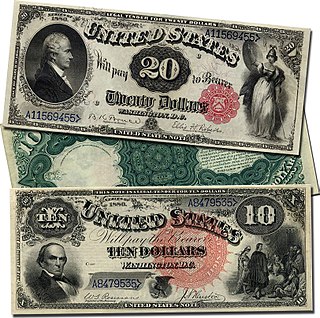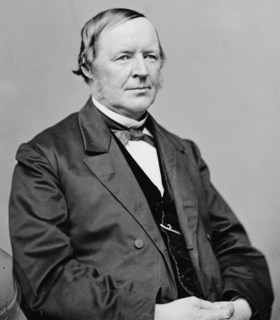
The Department of the Treasury (USDT) is an executive department and the treasury of the United States federal government. Established by an Act of Congress in 1789 to manage government revenue, the Treasury prints all paper currency and mints all coins in circulation through the Bureau of Engraving and Printing and the United States Mint, respectively; collects all federal taxes through the Internal Revenue Service; manages U.S. government debt instruments; licenses and supervises banks and thrift institutions; and advises the legislative and executive branches on matters of fiscal policy.
The National Banking Acts of 1863 and 1864 were two United States federal banking acts that established a system of national banks, and created the United States National Banking System. They encouraged development of a national currency backed by bank holdings of U.S. Treasury securities and established the Office of the Comptroller of the Currency as part of the United States Department of the Treasury and a system of nationally chartered banks. The Act shaped today's national banking system and its support of a uniform U.S. banking policy.

The Federal Reserve Act was passed by the 63rd United States Congress and signed into law by President Woodrow Wilson on December 23, 1913. The law created the Federal Reserve System, the central banking system of the United States.
Seigniorage, also spelled seignorage or seigneurage, is the difference between the value of money and the cost to produce and distribute it. The term can be applied in two ways:

The Australian dollar is the currency of Australia, including its external territories: Christmas Island, Cocos (Keeling) Islands, and Norfolk Island. It is officially used as currency by three independent Pacific Island states: Kiribati, Nauru, and Tuvalu. It is legal tender in Australia. Within Australia, it is almost always abbreviated with the dollar sign ($), with A$ or AU$ sometimes used to distinguish it from other dollar-denominated currencies. The $ symbol precedes the amount. It is subdivided into 100 cents.

A United States Note, also known as a Legal Tender Note, is a type of paper money that was issued from 1862 to 1971 in the U.S. Having been current for 109 years, they were issued for longer than any other form of U.S. paper money. They were known popularly as "greenbacks", a name inherited from the earlier greenbacks, the Demand Notes, that they replaced in 1862. Often termed Legal Tender Notes, they were named United States Notes by the First Legal Tender Act, which authorized them as a form of fiat currency. During the 1860s the so-called second obligation on the reverse of the notes stated:
This Note is a Legal Tender for All Debts Public and Private Except Duties On Imports And Interest On The Public Debt; And Is Redeemable In Payment Of All Loans Made To The United States.
Legal tender is a medium of payment recognized by a legal system to be valid for meeting a financial obligation. Each jurisdiction determines what is legal tender, but essentially it is anything which when offered ("tendered") in payment of a debt extinguishes the debt. There is no obligation on the creditor to accept the tendered payment, but the debt is nevertheless discharged. The creditor is not obligated to give change. Some jurisdictions allow contract law to overrule the status of legal tender, allowing for example merchants to specify that they will not accept cash payments. Coins and banknotes are usually defined as legal tender in many countries, but personal cheques, credit cards, and similar non-cash methods of payment are usually not. Some jurisdictions may include a specific foreign currency as legal tender, at times as its exclusive legal tender or concurrently with its domestic currency. Some jurisdictions may forbid or restrict payment made by other than legal tender.

The Central Bank of Ireland is Ireland's central bank, and as such part of the European System of Central Banks (ESCB). It is the country's financial services regulator for most categories of financial firms. It was the issuer of Irish pound banknotes and coinage until the introduction of the euro currency, and now provides this service for the European Central Bank.

Hugh McCulloch, a New England Yankee, was an American financier who played a central role in financing the American Civil War. He served two non-consecutive terms as U.S. Treasury Secretary under three presidents. He was originally opposed to the creation of a system of national banks, but his reputation as head of the Bank of Indiana 1857 to 1863 persuaded the Treasury to bring him in to supervise the new system as Comptroller of the Currency 1863-65. As Secretary of the Treasury 1865-69 he reduced and funded the gigantic Civil War debt of the union, and reestablish the federal taxation system across the former Confederacy. He tried but failed to make a rapid return to the gold standard.
This history of central banking in the United States encompasses various bank regulations, from early "wildcat" practices through the present Federal Reserve System.
The colón was the currency of El Salvador between 1892 and 2001, until it was replaced by the U.S. dollar. It was subdivided into 100 centavos and its ISO 4217 code was SVC. The plural is "colones" in Spanish and the currency was named after Christopher Columbus, known as Cristóbal Colón in Spanish.
The history of the United States Dollar refers to more than 240 years since the Continental Congress of the United States authorized the issuance of Continental Currency in 1775. On April 2, 1792, the United States Congress created the United States dollar as the country's standard unit of money. The term dollar had already been in common usage since the colonial period when it referred to eight-real coin used by the Spanish throughout New Spain.
The Independent Treasury was the system for managing the money supply of the United States federal government through the U.S. Treasury and its sub-treasuries, independently of the national banking and financial systems. It was created on August 6, 1846 by the 29th Congress, with the enactment of the Independent Treasury Act of 1846, and it functioned until the early 20th century, when the Federal Reserve System replaced it. During this time, the Treasury took over an ever-larger number of functions of a central bank and the U.S. Treasury Department came to be the major force in the U.S. money market.

Early American currency went through several stages of development during the colonial and post-Revolutionary history of the United States. Because few coins were minted in the thirteen colonies that became the United States, foreign coins like the Spanish dollar were widely circulated. Colonial governments sometimes issued paper money to facilitate economic activities. The British Parliament passed Currency Acts in 1751, 1764, and 1773 that regulated colonial paper money.
The Legal Tender Cases were two 1871 United States Supreme Court cases that affirmed the constitutionality of paper money. The two cases were Knox v. Lee and Parker v. Davis.

The United States dollar is the official currency of the United States and its territories per the Coinage Act of 1792. One dollar is divided into 100 cents or 1000 mills. The Coinage Act of 1792 created a decimal currency by creating the following coins: tenth dollar, one-twentieth dollar, one-hundredth dollar. In addition the act created the dollar, half dollar, and quarter dollar coins. All of these coins are still minted in 2020.
Boyer v. Boyer, 113 U.S. 689 (1885), was a suit in error brought in a state court of Pennsylvania for an injunction restraining the commissioners of Schuylkill County from levying a county tax for the year 1883 upon certain shares in the Pennsylvania National Bank, an association organized under the National Banking Act. The suit proceeds upon the ground that such levy violates the act of Congress prescribing conditions upon state taxation of national bank shares in this, that "other moneyed capital in the hands of individual citizens" of that county is exempted by the laws of Pennsylvania from such taxation. A demurrer to the bill was sustained and the suit was dismissed. Upon appeal to the Supreme Court of Pennsylvania, that judgment was affirmed on the ground that the laws of the state under which the defendants sought to justify the taxation were not repugnant to the act of Congress.

Bills of credit are documents similar to banknotes issued by a government that represent a government's indebtedness to the holder. They are typically designed to circulate as currency or currency substitutes. Bills of credit are mentioned in Article One, Section 10, Clause One of the United States Constitution, where their issuance by state governments is prohibited.

In monetary economics, the currency in circulation in a country is the value of currency or cash that has ever been issued by the country’s monetary authority less the amount that has been removed. More broadly, money in circulation is the total money supply of a country, which can be defined in various ways, but always includes currency and also some types of bank deposits, such as deposits at call.
The Coinage Act of 1834 was passed by the United States Congress on June 28, 1834. It raised the silver-to-gold weight ratio from its 1792 level of 15:1 to 16:1 thus setting the mint price for silver at a level below its international market price. After its passage, one ounce of gold was the equivalent of $20.67. The silver content of the silver dollar was left unchanged at 371.25 grains and the fine content of gold coins was reduced from 24.75 grains to 23.2 grains per dollar of face value.










